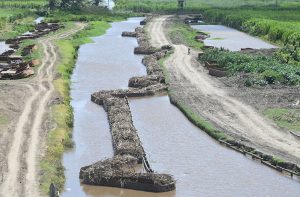WHILE the recovery of Guyana’s ailing sugar industry hinges on prudent management and the careful allocation of resources, a critical element in saving ‘sugar’ is also pest control, which draws about $30 million annually from the budget of the Albion Sugar Estate alone. Albion Estate, one of three producing sugar estates, is currently the country’s largest producer of sugar, and this is expected to continue in the near term as the output from 3,900 hectares of land is anticipated to be 261,000 tonnes of cane this crop. “Out of that, we expect to produce in excess of 21,750 tonnes of sugar, with a TCTS [tonnes cane to tonnes sugar] average of 12.5,” Manager of the Albion Estate, Threbhowan Shivprasad said during a comment following a tour of the estate last Wednesday.

This crop will last for about 12 weeks, ending in May with the estate hopefully reaching its target of 21,750 tonnes of sugar, which is about 50 per cent of its total production. In advancing its plans for this crop, as is the case every year, the estate will be placing emphasis on pest control. Shivprasad said pest control at the estate usually costs between $20 million and $30 million every year, as the integrated pest-management plan is comprehensive and encompasses manual and other cultural practices, sanitation work, and purchasing of chemicals. This investment is necessary because, if left unattended, some pests such as savannah rats and termites could decimate an entire cultivation. According to the Guyana Sugar Corporation (GuySuCo)’s website, termites, hard-back beetles and leaf-eating caterpillars damage cane on occasions, but all are adequately controlled by cultural practices or indigenous, natural enemies.
The savannah rat (holochilus brasiliensis), on the other hand, damages sugarcane during the periods of migration and mating, especially where estates border the savannahs. Management of this pest is through hunting, habitat management and baiting with anticoagulants. “Your whole business could be disrupted with rats… termites as well could affect the quality of cane and kill the entire business… all of those things could affect us,” Shivprasad said. Weeds are also considered as another traditional ‘pest,’ which competes with the sugarcane for nutrients. In excess of 40 per cent of the yield could be lost to weeds if it is not managed.
While the methods for managing weeds are quite clear, Shivprasad said the successful eradication of this pest depends heavily on the timeliness of control.
“If you do not control it before the seeding stage, it would shed and it would form a seed bank… it is important to apply chemical weed control on time,” the estate manager said.
The estate, in moving forward, will be looking to ensure that pest control is secondary, since the ultimate focus of the industry at this time is on reaching to a point of viability. Access to financing has improved the prospects at the Albion Sugar Estate, where authorities are looking to ramp up operations and upgrade the facilities there, through an investment of more than $2 billion in capital works. Shivprasad said over $2 billion has been set aside for work which will stretch from the field to the factory. “The factory would take 40 per cent and agriculture, 60 per cent… this includes machinery and equipment, the infrastructure like bridges, revetment and so on, so it would take a large sum,” he related. The need for critical work at the estate was exposed during the second crop of 2020, when the estate had ‘a lot’ of downtime.



.jpg)









